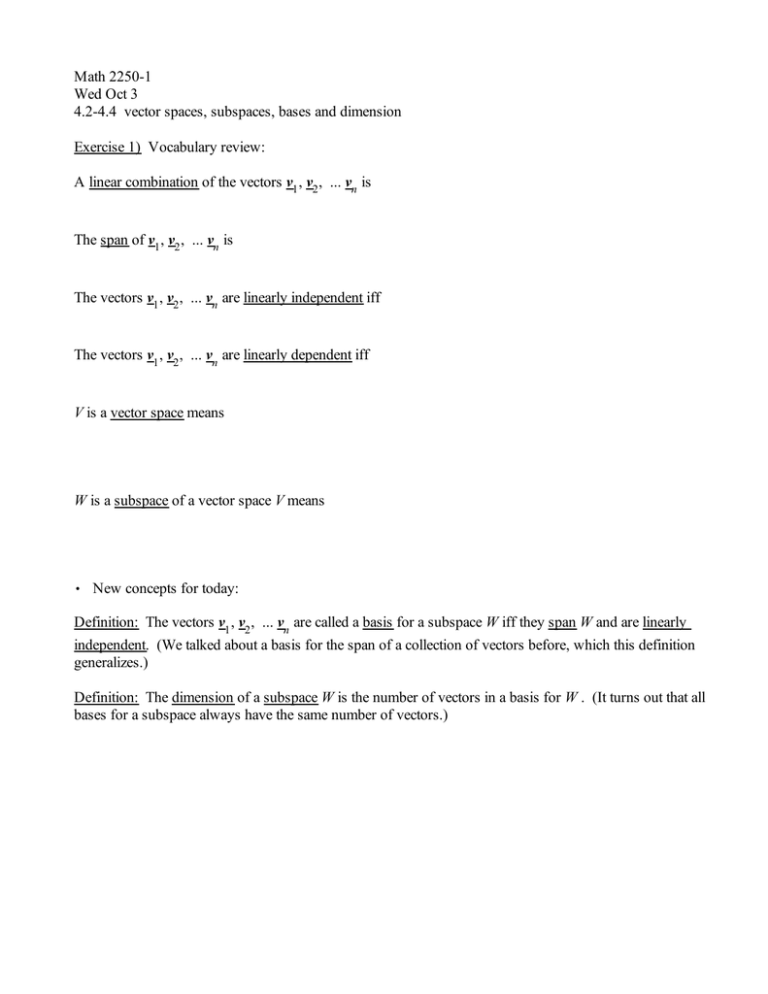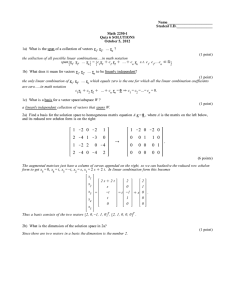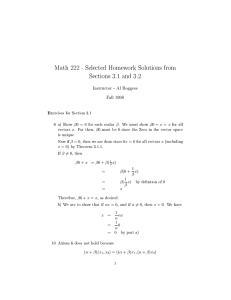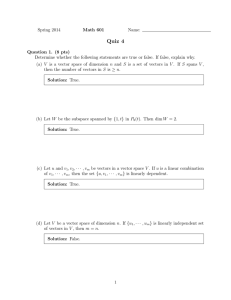Math 2250-1 Wed Oct 3 Exercise 1) Vocabulary review:
advertisement

Math 2250-1 Wed Oct 3 4.2-4.4 vector spaces, subspaces, bases and dimension Exercise 1) Vocabulary review: A linear combination of the vectors v1 , v2 , ... vn is The span of v1 , v2 , ... vn is The vectors v1 , v2 , ... vn are linearly independent iff The vectors v1 , v2 , ... vn are linearly dependent iff V is a vector space means W is a subspace of a vector space V means , New concepts for today: Definition: The vectors v1 , v2 , ... vn are called a basis for a subspace W iff they span W and are linearly independent. (We talked about a basis for the span of a collection of vectors before, which this definition generalizes.) Definition: The dimension of a subspace W is the number of vectors in a basis for W . (It turns out that all bases for a subspace always have the same number of vectors.) Yesterday we showed in an example that the span of two particular vectors was a subspace. Exactly the same idea shows a much more general fact: Theorem 1) The span of any collection of vectors v1 , v2 , ... vn in =m (or actually the span of any f1 , f2 , ... fn in some vector space V) is closed under addition and scalar multiplication, and so is a subspace of =m (or V . why: We need to show W d span v1 , v2 , ... vn is a closed under addition and b closed under scalar multiplication. Let v = c1 v1 C c2 v2 C ...C cn vn 2 W w = d1 w1 C d2 w2 C ...C dn wn 2 W a Then using the algebra properties of addition and scalar multiplication to rearrange and collect terms, v C w = c1 C d1 v1 C c2 C d2 v2 C ...C cn C dn vn . Thus v C w is also a linear combination of v1 , v2 , ... vn , so v C w 2 W is true. b Using algebra to rearrange terms we also compute c v = cc1 v1 C cc2 v2 C ...C ccn vn 2 W But most subsets are not subspaces: (This was Exercise 5 yesterday): Exercise 1) Show that 1a) W = x, y T 2 =2 s.t. x2 C y2 = 1 is not a subspace of =2 . 1b) W = x, y T 2 =2 s.t. y = 3 x C 1 is not a subspace of =2 . 1c) W = x, y T 2 =2 s.t. y = 3 x is a subspace of =2 . Then find a basis for this subspace. What is the dimension of this subspace? A The geometry of subspaces in =m is pretty special: Exercise 2) Use matrix theory to show that the only subspaces of =2 are (0) The single vector 0, 0 T , or (1) A line through the origin, i.e. span u for some non-zero vector u , or (2) All of =2 . Exercise 3) Can you use matrix theory to show that the only subspaces of =3 are (0) The single vector 0, 0, 0 T , or (1) A line through the origin, i.e. span u for some non-zero vector u , or (2) A plane through the origin, i.e.span u, v where u, v are linearly independent, or (3) All of =3 . Exercise 4) What are the dimensions of the subspaces in Exercise 2 and Exercise 3? 2 Exercise 5) Yesterday we showed that the plane spanned by 1 , 1 K1 1 has implicit equation K5 K2 x C 3 y C z = 0 . Suppose you were just given the implicit equation. How could you find a basis for this plane? This discussion leads to Theorem 2: Let Am # n be a matrix. Consider the solution space W of all solutions to ths homogeneous matrix equation Ax=0 , i.e. W = x 2 =n s.t. Am # n x = 0 . Then W 4 =n is a subspace. Furthermore, you can find a basis for this subspace by backsolving from the reduced row echelon form of A: once you write the solution in linear combination form x = c1 v1 C c2 v2 C ...C ck vk the vectors v1 , v2 , ... vk will always be linearly independent. Thus, since these vectors span W by construction, v1 , v2 , ... vk are a basis for W. Exercise 6) Check that a , b hold for the solution space W to A x = 0 , i.e to verify that W = x 2 =n s.t. Am # n x = 0 is indeed a subspace. Illustrate how to find a basis for the solution space to a homogeneous matrix equation by completing this large example: Exercise 7) Consider the matrix equation A x = 0 , with the matrix A (and its reduced row echelon form) shown below: 1 2 0 1 1 2 1 2 0 1 1 2 A := 2 4 1 K1 K2 1 4 1 7 1 K2 1 / 0 0 1 2 K1 3 0 0 0 0 0 0 K2 K4 0 K2 K2 K4 0 0 0 0 0 0 7a) Find a basis for the solution space W = x 2 =6 s.t. A x = 0 by backsolving, writing your explicit solutions in linear combination form, and extracting a basis. Explain why these vectors span the solution space and verify that they're linearly indepdendent. 7b) What is the dimension of W ? How is the dimension related to the shape of the reduced row echelon form of A? 7c) Since solutions to homogeneous matrix equations are exactly linear dependencies between the columns of the matrix, your basis in 7a can be thought of as a "basis" of the key column dependencies. Check this. (By the way, this connection between homogeneous solutions and column dependencies is the reason why any matrix has only one reduced row echelon form - the four conditions for rref (zero rows at bottom, non-zero rows start with leading ones, leading ones in successive rows move to the right, all column entries in any column containing a leading "1" are zero except for that "1"), together with specified column dependencies uniquely determine the rref matrix.)







